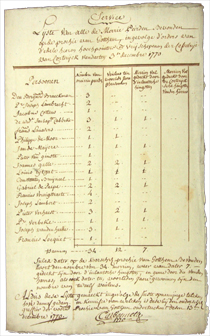
3. The need for early modern statistics

The period prior to the 19th century is known for its lack of statistics. Collated figures on demographic, economic and social developments of the time are scarce. Up until the French revolution, the authorities organized few censuses or inquiries with regard to the country, its inhabitants or society that went further than the local situation. Historians themselves must therefore extract the data from the sources and quantify them in order to arrive at larger patterns. This is for various reasons a difficult process. Firstly, foreknowledge is required in order to understand the terminology, language and handwriting from a fairly distant past. The available sources provide an abundant supply of individual details that have to be sifted and counted in order to extract useable data sets from them. To be useful for quantitative and computerized research, moreover, the original data must be recorded according to strict criteria. This is frequently not the case, where the historical documents reveal lapses or were not systematically compiled. Such limitations entail a lot of preparatory work in order to transform sources into reliable research material. The STREAM project has been set up in order to surmount such obstacles and provide valuable statistics for early modern historical research.
1. Science in ferment
2. Limits to knowledge
3. The need for early modern statistics